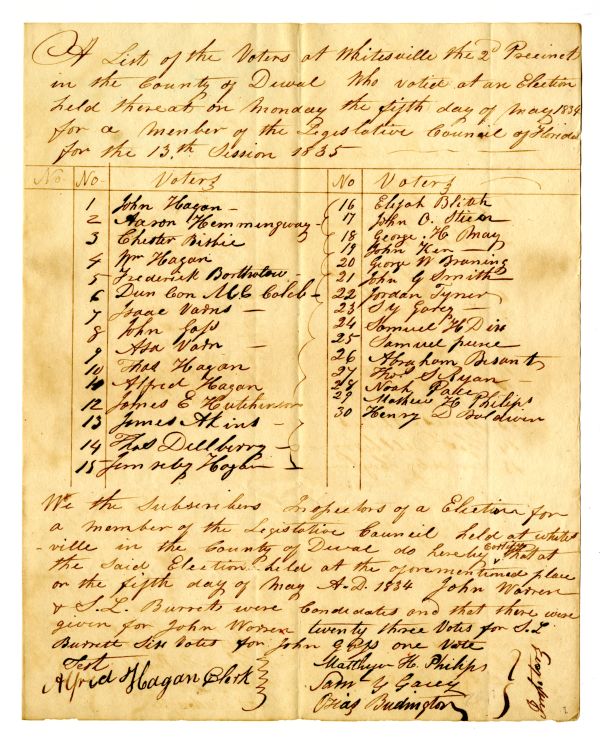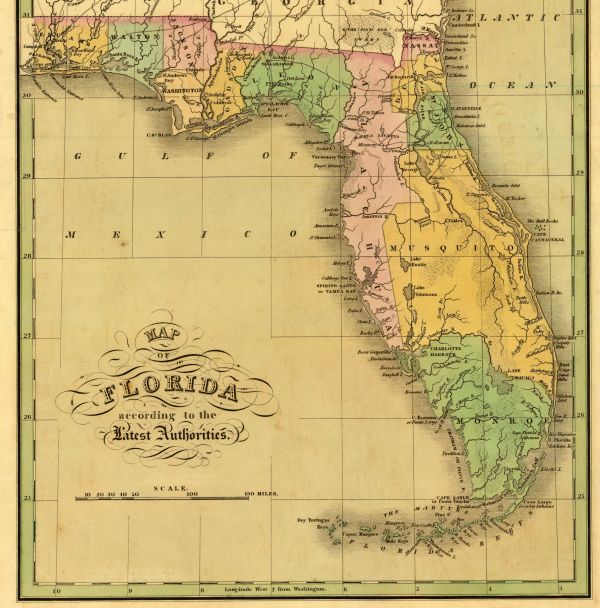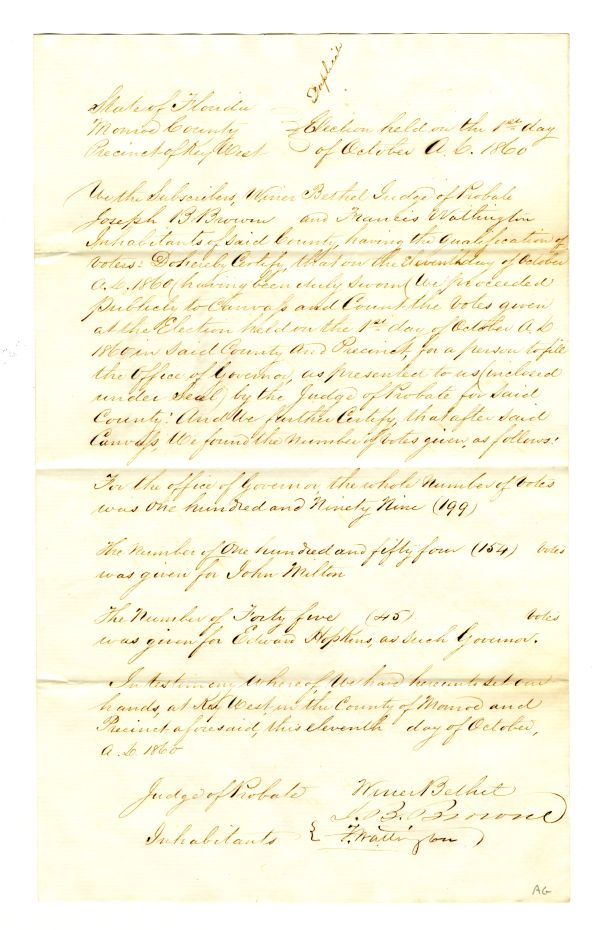Description of previous item
Description of next item
Election Returns as a Genealogical Resource
Published November 11, 2020 by Florida Memory
The State Archives of Florida is home to around 50,000 cubic feet of historical records, the vast majority of which document the functions of Florida’s state and territorial governments. Many of these records can be valuable tools for genealogists searching for ancestors who may not be documented in other common sources like the federal census. It isn’t always obvious, but sometimes what looks like a mundane, routine government record on the surface can be just the right tool for breaking through one of those famous “brick walls” that so often challenge family history researchers.
The antebellum-era election returns in Series S21 are a prime example. In Florida’s earliest territorial days, there were a limited number of elected offices and a much smaller population, which was reflected in the simplicity of the elections system. There were no public officials appointed or elected specifically to supervise elections—that job fell to the judges of the county courts. Each county judge was to establish voting precincts and select “judges” to supervise them. Each precinct’s judges, also called inspectors, would then select a clerk to help them with the paperwork. The results of the election in each precinct were communicated to the governor in Tallahassee in the form of a certificate made out by the clerk and judges that generally included the names of every voter who participated. The county sheriff was responsible for ensuring that each precinct’s return made it to the capital.

Election Return for Whitesville in Duval County, May 5, 1834. Click or tap the image to view a zoomable version of the complete document.
Besides the obvious benefit of providing fascinating lists of names, these records have two important qualities going for them. First, they are geographically very granular in nature. The individuals in these returns are being tied not only to a specific county, but also to a specific area within that county. For some of the voters, this may be the most precise description available of where they lived. Because so many Floridians from this era were squatters and did not hold title to the land they lived on, tracing their specific whereabouts through deeds and land patents isn’t always possible. These election returns may not provide a legal description of an ancestor’s land, but knowing which precinct they voted at can at least narrow down the area where they would have lived within a county. And that can make a big difference when you're looking at a time when the entire Florida peninsula was divided up into only a handful of counties.

Excerpt from Finley's 1827 map of Florida showing the county boundaries in place at that time. Click or tap the image to view a zoomable version of the complete map.
Secondly, unlike the federal census, which was only taken once a decade, these records were generated every time there was an election. That’s a lot of data points—sometimes more than one per year. Because researchers can often compare election returns over time, it allows them to see when a particular individual began voting in a county and when they stopped, which can help establish a timeline for a family’s migration into and around Florida. The system isn’t perfect, of course. Just like today, there were plenty of people in the antebellum era who either didn’t vote or voted irregularly. It’s also important to point out that the records are fragmentary, particularly for smaller counties or ones located especially far away from Tallahassee. Still, when it comes to tracing ancestors in the first half of the 19th century, any quality data points are better than none.
Series S21 contains election records spanning more than a century from 1824 to 1926, but it’s important to note that the form these records take changes over time, and generally the more recent records are not as thorough as the antebellum ones. This is because local officials eventually began maintaining lists of voters at the county level, so precinct certificates sent to Tallahassee did not have to include the voter names like they once did. These more recent records are still interesting, however, because they contain the names of the election inspectors and all the candidates for office who received votes (as opposed to just the winners). Also, on at least a few occasions, counties forwarded copies of their poll books to the Secretary of State, and those are part of Series S21 as well. Those poll books contain the names of all registered voters in the county for a given year, whether they voted or not.

Election Return for Key West in Monroe County, October 1, 1860. Click or tap the image to view a zoomable version of the complete document.
Series S21 is not available online just yet, but getting copies of a particular election return is easy. A box listing for the series is available through the Archives Online Catalog. The fastest way to reach the catalog record for Series S21 is to search for “election returns by county” (use quotes) at the Series/Collection level. Once you have accessed the catalog record for Series S21, click the yellow folder icon on the left to display the list of boxes. The range of years for which records are available is given for each county. Again, it is important to note that records will not be available for every year within those ranges, and the type of information contained in the records will change over time. Once you have identified the boxes that interest you, contact the Reference Desk by email at Archives@dos.myflorida.com or by phone at 850.245.6719 to request copies of specific records. Our Reference Archivists will pull the boxes you identify and look for election records that cover the counties and time periods you are looking for. You’ll have an opportunity to select specific returns from what they find.
While you’re waiting to receive your copies from Series S21, don’t forget to take a look at the election records from other series that have already been made available on FloridaMemory.com. Both the returns from Florida’s first election of state officials in 1845 and the statewide voter registration rolls created in 1867 and 1868 are fully searchable and browsable—you can find both sets of records on the Historical Records page under the Discover menu.
Cite This Article
Chicago Manual of Style
(17th Edition)Florida Memory. "Election Returns as a Genealogical Resource." Floridiana, 2020. https://www.floridamemory.com/items/show/346081.
MLA
(9th Edition)Florida Memory. "Election Returns as a Genealogical Resource." Floridiana, 2020, https://www.floridamemory.com/items/show/346081. Accessed December 21, 2025.
APA
(7th Edition)Florida Memory. (2020, November 11). Election Returns as a Genealogical Resource. Floridiana. Retrieved from https://www.floridamemory.com/items/show/346081

 Listen: The Latin Program
Listen: The Latin Program